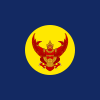Bidyalongkorn
| Bidyalongkorn | |
|---|---|
| Prince Bidyalongkorn | |
 | |
| Born | 10 January 1876 Bangkok, Siam |
| Died | 23 July 1945 (aged 69) Bangkok, Thailand |
| Spouse | Phat Bunnag Barabimalabanna Voravan |
| Issue | Princess Vibhavadi Rangsit Prince Bhisadej Rajani and nine other children |
| House | Rajani family (Chakri Dynasty) |
| Father | Wichaichan |
| Mother | Lady Liam-lek |
| Signature | |
Rajani Chamcharas, the Prince Bidyalongkorn[a] (Thai: รัชนีแจ่มจรัส; RTGS: Ratchani Chaemcharat; 10 January 1876[2] – 23 July 1945[3]) was a prince of Thailand. He was a member of the Thai royal family, the 22nd child of Prince Wichaichan and the second of Khun Chom Manda Liam,[2] and thus a great-grandson of Rama II. His many descendants use the Royal surname Rajani (Thai: รัชนี; RTGS: Ratchani). The Historical Dictionary of Thailand notes:
He studied at Suan Gulab and at Cambridge in England. He served in high-level administrative positions in the Ministry of Public Instruction and also the Ministry of Finance. He accompanied King Rama V (Chulalongkorn) on his first visits to Europe. Upon returning from Cambridge, in 1901, he started the magazine Lak Wittaya (Stealing Knowledge), which provided translations of Western literary works and offered the Siamese a chance to publish their literary work.[4]
Tai linguist William J. Gedney called him "probably Thailand's most gifted man of letters of the twentieth century".[5] James N. Mosel, discussing Thai poetry of the early and mid 20th century, notes that:
[He] ranks as one of the greatest poets of modern times, although his first works were in fiction, where, under the pen-name of "N.M.S."[b] he achieved wide popularity as a humorist. In poetry he is famous for his Konok Nakhon ("City of Gold"), a Thai adaptation of an English translation of a Sanskrit work. His magnum opus is Sam Krung ("Three Capitals"), a lengthy epic recounting the turbulent period in Thai history when Ayutthaya, Thonburi, and Bangkok successively became the Thai capital.[6]
King Rama VI (Vajiravudh), himself an accomplished author and translator, formed a literary club to promote good writing in Thailand. Bidyalongkorn, a member of the club, formulated a series of rules encouraging correct and concise language, as well as strict observance of classic Thai verse structures.[7] An innovator as well as a traditionalist, he was an influential adopter of novel meters of the chan verse type which, before 1913, had remained unchanged for centuries.[8]
Selected works
- Vetala Tales (Thai: นิทานเวตาล; RTGS: Nithan Wetan) (1918) — a Thai version of the Baital Pachisi, based chiefly on Richard Francis Burton's retelling
- "The Pastime of Rhyme-Making and Singing in Rural Siam" (PDF). Journal of the Siam Society. 20 (2): 101–127. October 1926. ISSN 0304-226X.
- "The Buddha's Footprints" (PDF). Journal of the Siam Society. 28 (1): 1–14. 1935. ISSN 0304-226X.
- "Sebhā Recitation and the Story of Khun Chāng Khun Phan" (PDF). Journal of the Siam Society. 33 (1): 1–22. March 1941. ISSN 0304-226X.
- Three Capitals (Thai: สามกรุง; RTGS: Sam Krung). Bangkok: Chaiyarit. 1952. OCLC 31593320.
- Montri Umavijani (1981). A Poetic Journey Through Thai History: Based on Prince Bidyalankarana's Sam Krung. Bangkok: National Identity Board. OCLC 10548242. — Discussion and excerpts in English
- Essays on Thai Poetry. Bangkok: Office of the National Culture Commission. 1981. OCLC 8718363.
Notes and references
Explanatory notes
Footnotes
- ^ Mosel 1961, p. 47.
- ^ a b Wibha Senanan 1973, p. 347.
- ^ Wibha Senanan 1973, p. 349.
- ^ Fry, Nieminen & Smith 2013, p. 62.
- ^ Gedney 1989, pp. 522–523.
- ^ Mosel 1961, p. 6.
- ^ Hudak 1990, p. 149.
- ^ Hudak 1990, p. 150.
References
- Fry, Gerald W.; Nieminen, Gayla S.; Smith, Harold E. (2013). Historical Dictionary of Thailand (3rd ed.). Plymouth, UK: Scarecrow Press. p. 62. ISBN 978-0-8108-7525-8.
- Gedney, William J. (1989). "Siamese Verse Forms in Historical Perspective". In Bickner, Robert J.; Hartmann, John; Hudak, Thomas John; Patcharin Peyasantiwong (eds.). Selected Papers on Comparative Tai Studies. Michigan Papers on South and Southeast Asia No 29. University of Michigan. pp. 489–544. ISBN 9780891480389.
- Hudak, Thomas J. (1990). The Indigenization of Pali Meters in Thai Poetry. Monographs in International Studies: Southeast Asia Series, #87. Athens, Ohio: Ohio University Center for International Studies. ISBN 0-89680-159-4.
- Mosel, James N. (1961). Trends and Structure in Contemporary Thai Poetry: With Translations and Bibliography. Ithaca, NY: Southeast Asia Program, Dept. of Far Eastern Studies, Cornell University. OCLC 3177676.
- Wibha Senanan (1973). The Genesis and Early Development of the Novel in Thailand (PDF) (Ph.D. thesis). School of Oriental and African Studies, University of London. OCLC 1079331426. Retrieved 2023-11-13.


